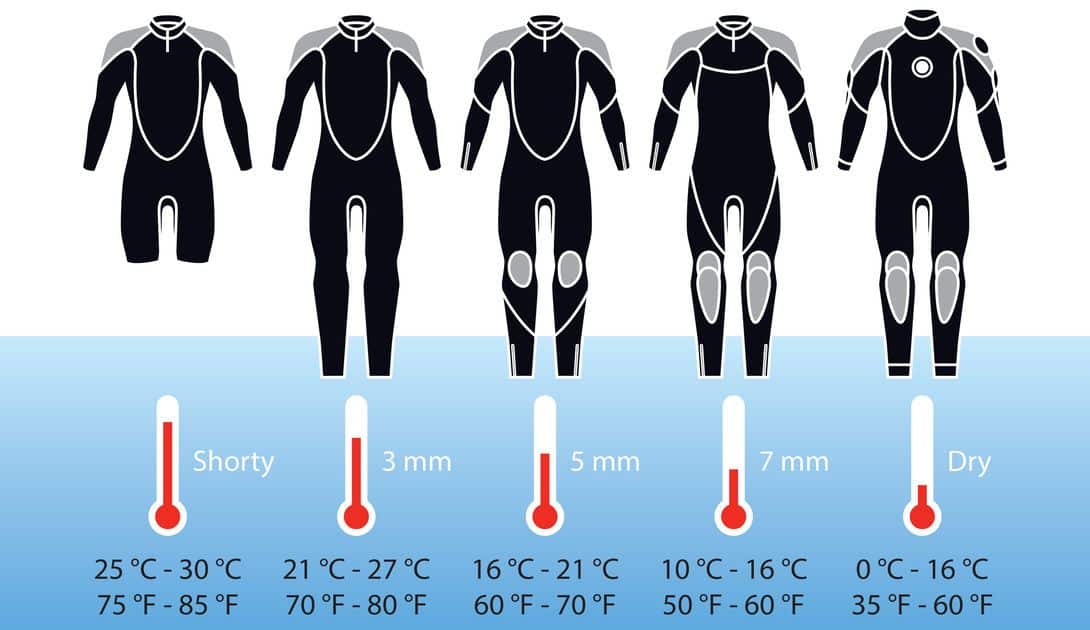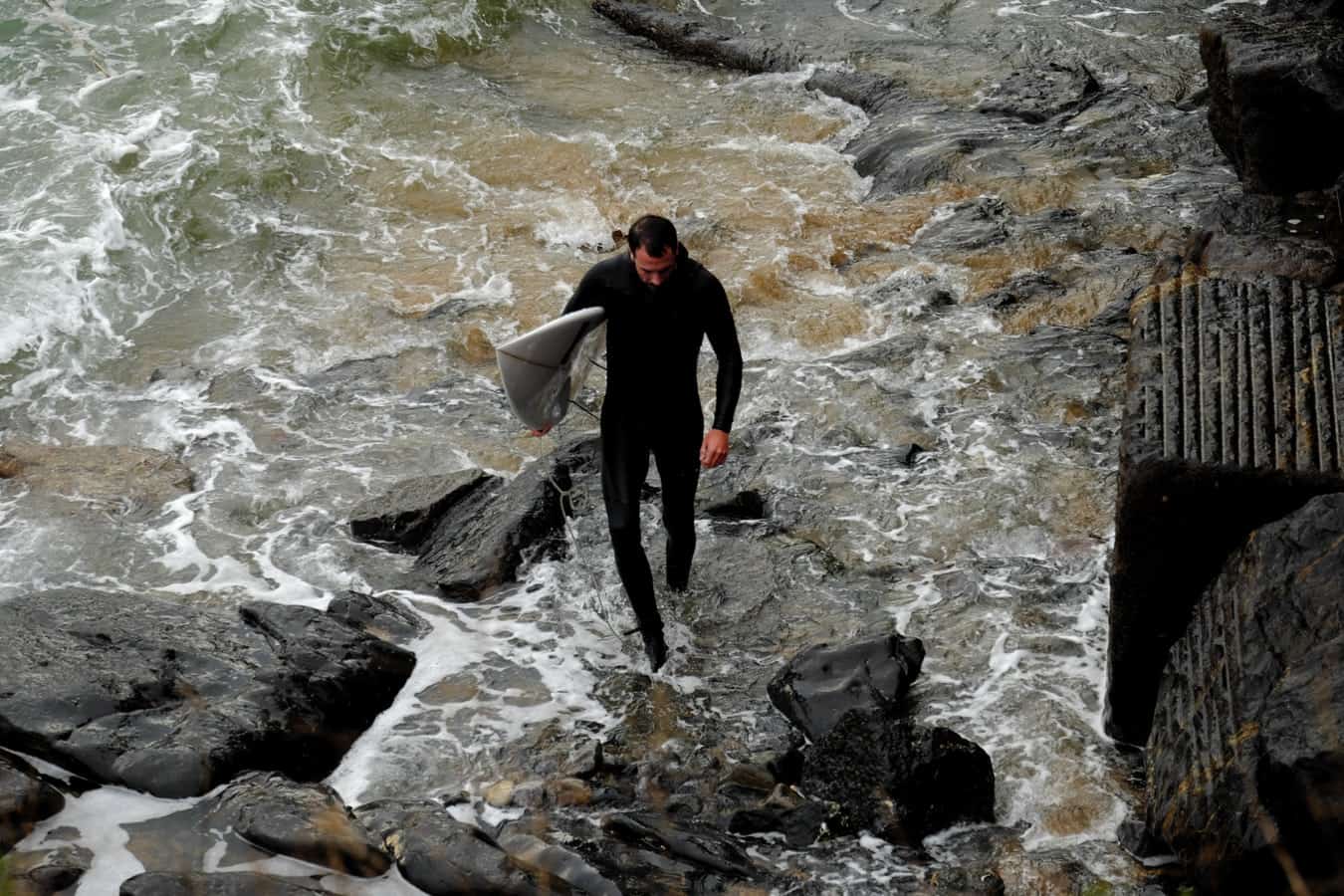The temperature of water in the Pacific ocean varies from a low of 50 degrees in the winter to a high of 75 degrees in the summer in Southern California. Dedicated surfers take to the water all through the year especially when the weather outside is nice and warm. In the middle of winter, you’ll find experienced surfers wearing wetsuits.
So, can I surf without a wetsuit? Yes, you can, in the summer when the water is warmer. Wear a wetsuit to keep your body warm. The next question is “Do I need to wear a wetsuit?” to which we answer, No, you do not. However, wearing a wetsuit has many advantages beyond keeping your body warm. Read through my article so you can determine when and when not to, wear one.
What Advantages Do Wetsuits Provide?
A good wetsuit will keep your body warm while absorbing moisture from your body at the same time. This is a process known as “wicking.” Now let us assume you’re surfing in temperate waters. The temperature is 71 degrees, so wearing a wetsuit is completely optional. However, if you decide to wear one, you can expect some advantages and disadvantages.
- Wetsuits help you float easier. If you are in waters full of waves and crosscurrents, a wetsuit keeps you buoyant, especially when you need to collect yourself and swim the currents towards the shore.
- You swim faster when you wear a wetsuit. If your goal for a day is to barrel as much as you can, and you notice a lot of tubing waves, then you can paddle faster towards the waves when you wear a swimsuit. A wetsuit is slick and smooth, so it dramatically reduces body resistance. Like a fish!
- Wetsuits keep you warm, especially in cold water. Even when the water temperature is warm, lots of surfers are sensitive to water temperature. If you’ve been out in the surf for hours and hours in warmer water, even an experienced swimmer can develop chills and feel cold. A swimsuit insulates the body from developing these symptoms and maintains your body temperature no matter how long you’re in the water.
What Are The Disadvantages To Wearing A Wetsuit?
- Wetsuits can be costly. Prices for a good wetsuit can range anywhere from $150.00 to over $1000.00 It’s a serious investment for serious surfers. You want to make the individual choice whether you want to enjoy the advantages of wearing a wetsuit. There is no question that it allows you to swim and paddle faster and to maintain steady, regular body temperature.
- They can make you feel constricted in your movements. Wetsuits are fit tight to the body. A loose-fitting suit would slow down your movements as if you’re carrying a ton of extra weight around you. Since it fits snug to the body, you are constantly aware you’re wearing it. It is especially tight across the chest, and the unyielding material may cause discomfort in some cases, and panic in others until you’ve become used to wearing one.
There is no doubt about the advantages of wearing a wetsuit. They are necessary when the water temperature is in the low 50s. However, never go into the water when the temperature is below 50 degrees; even a wetsuit won’t insulate you from water this cold.
What Kind Of Wetsuit Is Best For Me?
Should you decide to buy a wetsuit, you should keep a few things in mind. Today, manufacturers make both winter wetsuits and summer wetsuits. Should you decide to invest in a wetsuit, keep in mind that you don’t need to wear it all the time. It’s a great idea to get a wetsuit, and then to spend time wearing it as often as you can until you feel comfortable in it.
Try swimming in it the first time you wear it, without your surfboard. Get a feel for the speeds at which you can swim and try diving with it underwater. Swim in your wetsuit until you’re comfortable, then grab your surfboard and hit the waves!
First, decide if you need a partial (spring wetsuit), or a full wetsuit. Next, find out the average water temperature in your favorite surf spot, so you can choose the right thickness of the wetsuit.
Modern-day wetsuits are made of neoprene. Neoprene is a synthetic rubber that will stretch easily, is flexible and, of course, water resistant. It has hundreds of uses including medical equipment, tire manufacturing, and is even found in some clothing designs. It is the perfect wetsuit material.
Wetsuits come in 3 different thicknesses. Thinner wetsuits are for warmer weather, while the thickest is designed for colder water temperatures.
- 3/2 mm Wetsuit: warm and mild water temperature
- 4/3 mm Wetsuit: Cold to mild water temperature
- 5/4 mm Wetsuit: Cold water temperature (above 50 degrees Fahrenheit).
If you surf or swim in year-round cold water climates, you will also need neoprene gloves, a hood, and shoes (booties).

Wetsuit Sizing
Wetsuits are like a second skin, so they will fit snugly against your body. Make sure to pick the right size wetsuit for maximum comfort so you get the most out of it.
Wetsuits come in sizes from 2 Extra Small to 3 Extra-large. You should know your body’s chest measurement and waist measurement, as well as your exact weight.
For example, if you are 5 feet 11 inches tall and weigh 165 pounds, make sure your chest measurement is between 40 inches and 42 and a half inches, and your waist is between 32 inches and 34 ½ inches. Should you fall within these ranges, the size wetsuit you buy will be a size “Large.”
If you are 5 feet 7 inches tall, and you weigh 139 pounds, your chest is 35 inches across and your waist is 30 inches, your size will compute to “Extra Small.”
Don’t ever guess your size wetsuit. Most of the better brands come with size charts, so match them up to the right size as perfectly as possible.
One of the highest rated wetsuit bands is O’Neill. Their wetsuits come in 15 different size categories, allowing you to get as close as possible to your body’s measurements.
What Are The Different Types Of Wetsuits?
- Semi-dry Wetsuit
Thick and warm, the semi-dry model is designed to keep you the warmest in the water. It zips across the chest and comes with a hood attached. It is a very thick neoprene at 8 mm across the chest.
The legs and arms are covered in 7 mm neoprene. The name-“semi-dry” is not to be taken, it does not keep the body completely dry, but it has great seals. However, it is so thick that only a very small amount of water enters the suit.
- 7 mm Wetsuit
The 7 mm wetsuit is a step down from the semi-dry 8 mm suit. This model is perfect for surfing in water temperatures between 50 and 60 degrees. Accessories for this suit can be a hood and booties as well as gloves to keep your whole body insulated.
Look for the word “hyper-stretch” when buying a 7 mm wetsuit, which will give the suit more give and less stiffness and rigidity when surfing. Besides, wetsuits this tick are harder to put on than thinner suits, so hyper-stretch is a definite advantage.
Other thicker types of wetsuit can also be used for scuba diving and may not translate well into surfing suits.
What Kind Of Designs Do Wetsuits Come In?
The warmer the water temperature, the more choices you have in a wetsuit. Not all wetsuits need to be full-body suits, as you can see from the following.
- Vest Wetsuit
A vest wetsuit is a vest only and has minimal neoprene but protects against the wind. This suit is perfect for surfing on a summer day and will protect the chest form chill and cold drafts. Your arms remain exposed, free to paddle and swim.
The vest is about 3 mm in thickness and wearing a bottom part to complete your wetsuit is not required, but it is recommended.
- Wetsuit Jacket
A wetsuit jacket covers the arms completely so the top part of your body stays warmer. This provides better protection against wind gusts and water.
Wetsuit jackets are about 2 mm thick, and it is advised to get a wetsuit jacket without a front zipper. These can add drag to your paddling and slow you down.
- Spring Wetsuit
This wetsuit covers much more of your body and it is great for use in the summer. The legs and arms are shortened so you don’t have resistance when paddling and kicking. In the hot summer, the suit protects your skin from sunburn. The Spring suit is a step down from a full body wetsuit.
Related Questions
Is Wearing A Full Suit Better Than A Partial Suit?
The answer depends on how much you want to invest in a wetsuit. If you want to surf all year round, then you’ll want to invest in a full body wetsuit. They can be used throughout the four seasons, and the best ones will be flexible enough, so you don’t feel constricted in them.
All wetsuits take time to get used to, but once you are comfortable you’ll forget you’re wearing a full body wetsuit so you can focus on approaching waves faster with greater buoyancy.
Are There Full Body Wetsuits That Come In Pieces?
If you want to remove parts of a full body wetsuit, most better brands will have “convertible” options, so you can remove the arms or the legs from the suit.
Wetsuits also come with different linings, and the best protect you from the water while at the same time allowing the body to breathe, as it absorbs sweat and water moisture from the body.
Can I Get A Wetsuit Customized?
Yes, you can! If you have certain preferences that mass-manufactured wetsuits don’t provide, you can get a suit made for your size and shape. Note that anything custom, suits, shoes, or any other clothing, will cost more.

